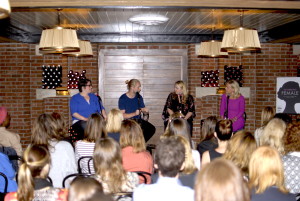“The Fabricated Female” — in Media, the VO Booth, and Beyond
Another angle on the “glass ceiling” recently went under the microscope in New York City.

(l-r) Julie Schubert, Felix Richter, Carrie Faverty, and Gretchen Carlson discussed “The Fabricated Female” at Lafatyette Cafe in New York City.
In a powerhouse meeting of the minds, Fox news anchor Gretchen Carlson moderated “The Fabricated Female: Deconstructing the Female ‘Type’ in Media versus Real Life.”
The big question at hand for the well-attended morning meeting was “Why are women continuously pigeonholed into categorical roles on screen?” Carlson quizzed her panelists on the existing limitations in casting for women, and the timeline for their roles to evolve beyond broad strokes of sexualization, age, and celebrity.
On hand to lend their perspective were Julie Schubert, the Emmy-winning Casting Director for House of Cards; Felix Richter, Creative Director for the hot NYC ad shop Droga5; and — representing for the audio post perspective — Carrie Faverty, Casting Director for the audio post shop Sound Lounge.
With her experience casting for both voice over and on-camera commercials for thousands of products, Webisodes, animated pilots, narrations, promos, and more, plus casting for over a dozen different languages, it’s fair to say Faverty has heard it all. For her, the subject matter of “Fabricated Female” has been all too ever-present in content production.
“It’s a constant struggle women face, and have faced for years, as to how the media treats them and portrays them,” Faverty says. “However, I do think that in the past couple of years, more attention has been brought to the fight. Campaigns like ‘Like a Girl’ (from Always) sheds light on the issues we face, not just in the media, but in the world as a whole. I’m just glad we had a chance to throw our opinions in the mix as well.”
As a VO casting director, as well as an instructor of the art, Faverty is witnessing first-hand the challenges that women face in the struggle against stereotypes, both onscreen and in the hyper-competitive voice over world – where advertisers often are ultimately calling the shots.
“I teach a lot to beginners looking to break into the voice over world,” she notes. “I would say 80% of my students are women. Sadly, I think maybe one out of 10 commercials has a female voice on it. These women are trying to break into an already oversaturated industry where the best case scenario is they can do 10% of the work that’s out there.
“It’s staggering to see — and hear — how infrequently women are represented in the voice over world,” she continues. “They are not considered for car campaigns, or investment companies, or even fast food. I’ve been doing this a long time and have always found it frustrating that women aren’t asked to voice more for the big brands.
As it did for many of the audience members, Faverty found that the “Fabricated Female” panel opened up some welcome windows of awareness. “I was particularly excited to hear what Julie Schubert had to say about casting on her side of things,” says Faverty. “I have such a limited scope being in commercial voiceover casting, but I think the trends happening with the film and TV world are more telling to what is happening to the industry as a whole. Her take on network TV vs. cable TV was fascinating. It was really interesting to hear how many times it circles back around to the advertisers, and what shows they want to use to market their product.”
— David Weiss
Please note: When you buy products through links on this page, we may earn an affiliate commission.






